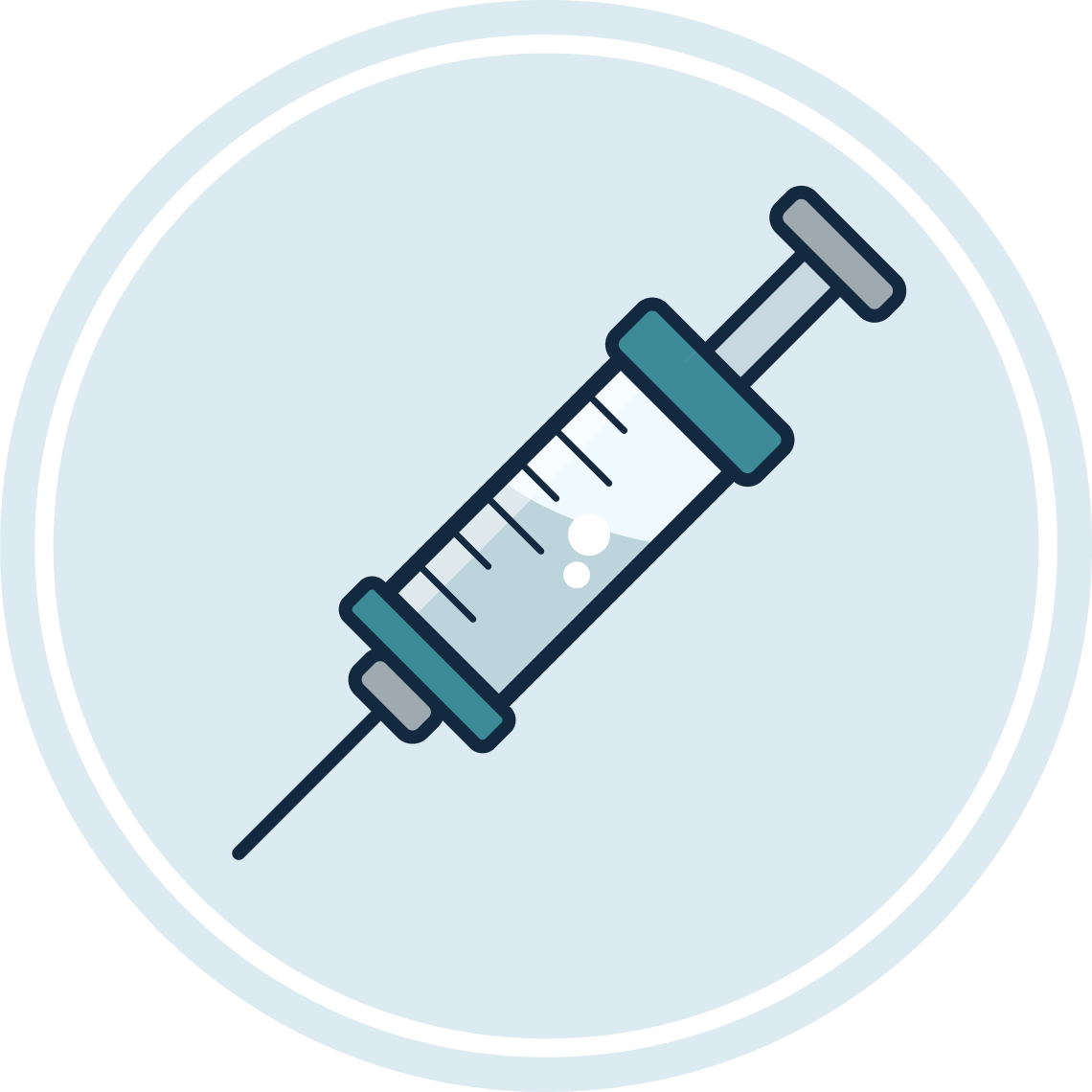Being a dog parent means you'll spend a few hours outside throughout your dog's lifetime. From daily walks to dog parks, canines thrive in the great outdoors.
The unfortunate reality is that pesky bugs, like mosquitoes and ticks, also live outdoors. Mosquitoes are most prevalent in areas with warm, humid climates. They can be found all over the United States throughout the year — similar to flea season. And, they can carry heartworms.
Dogs that spend a lot of time outdoors where mosquitoes thrive may be at risk of heartworm infection. Heartworm disease can cause serious health problems for your pet. So, it's important to know how dogs get heartworms and what you can do to prevent them.
In this article, we'll explore:
- What are heartworms
- How and where dogs get them
- What is heartworm disease
- How to tell if your dog has a heartworm infection
- What to do if your dog has heartworm disease
- The best way to prevent it
What are heartworms
Heartworms are long, parasitic worms that are transmitted to dogs through infected mosquitoes. They usually live in the blood vessels of animals — near the heart and lungs.
Fully-grown, female heartworms can reach up to 14 inches long, while males reach about half that size. An infected animal can inhabit more than 300 worms at one time. This combination of quantity and size in your pet's heart and lungs can turn fatal very quickly.
What are the life stages of heartworm
The heartworm life cycle has three distinct stages from larvae to adult worms:
- L1 - Heartworm larvae
- L2 - Immature adults (microfilariae)
- L3 - Adult heartworms
The cycle typically begins when an infected mosquito bites your dog. An infected female mosquito bites your dog and transmits immature heartworms, called microfilariae, into the bloodstream.
Larvae
After an infected mosquito bites your dog, the infective larvae enter through the wound. The larvae travel through your dog's bloodstream to different organs where they develop into adult worms and mate.
Infective larvae are the most dangerous stage because they migrate through the blood vessels into your dog's lungs. After about four weeks, infective larvae start to grow into microfilariae. Then they make their way to the right side of your dog's heart.
Immature heartworms
Infective heartworm larvae will eventually reach the immature stage. The microfilariae travel to the heart and lungs where they mature into adults.
Immature worms develop for several weeks before reaching adulthood. After that, they mature into foot-long adult heartworms that live in the right heart chamber and pulmonary arteries.
Adult heartworms
The time it takes for these parasites to grow into adult heartworms depends on the age of your dog. Younger, smaller dogs can take as little as three months to become infected. Larger breeds may take up to six or seven months.
When adult heartworms are present, they can cause:
- Aortic valve insufficiency
- Pulmonary hypertension
- Right-sided heart failure
Adult female heartworms deposit their eggs in your dog's blood supply and travel back to the original site. These eggs then pass to new mosquitoes when they take a blood meal from an infected animal. This ensures the life cycle continues again and again.
Where and how do dogs get heartworm disease

Heartworm disease is a serious infection for dogs. Mosquitoes are the primary hosts of heartworms and live all over the world.
If you live in an area with lots of mosquitoes, your dog's risk of heartworm infection is much higher. The most common high-traffic states are in the South.
These include:
- Alabama
- Florida
- Georgia
- Louisiana
- North Carolina
- South Dakota
- Oklahoma
- Texas
- Virginia
Heartworm disease affects dogs of all shapes and sizes. This includes puppies, adult dogs, active dogs, sedentary pups, and all breeds and genders.
Pets or infected animals
The parasites that cause heartworm disease, rely on the blood of animals. When mosquitoes bite and carry an infective heartworm from another animal, that mosquito bite could transmit disease to your pet.
Heartworm is most commonly spread through direct contact with infected animal urine or feces. Or, by consuming one that has already passed away from symptoms caused by heartworm disease. Heartworm infection can also happen by direct exposure to another infected dog.
The American Heartworm Society states that heartworm infections can affect dogs, cats, and ferrets. They also can affect foxes, coyotes, wolves, sea lions, and humans (in rare cases).
DID YOU KNOW?
Heartworm disease in cats is different from dogs. Infected cats typically only have a few worms and most never reach a fully-developed adult stage. But they still create blockages and blood flow restriction causing lots of other problems.
Blood transfusions
If donated blood or organs come from a heartworm-infected dog, it's possible for your dog to contract heartworm. However, adult heartworms typically die long before a transfusion. Also, most dogs have to undergo testing before they become donors.
Humans
Dogs cannot get heartworm infections from humans. Canine heartworm disease occurs when a specific parasitic worm is transmitted to dogs. Humans do not carry this type of worm and cannot transmit it to dogs or other animals.
What is heartworm disease

Heartworm disease is a serious infection. Heartworm disease occurs from an infestation of a worm called Dirofilaria immitis. This parasite transmits through infected mosquitoes which travel through the bloodstream to your dog's heart and lungs.
Untreated, heartworms can remain there for up to five years. Once in the body, the worms live on the right side of your dog’s heart and pulmonary arteries. These are the major blood vessels leading to your dog's lungs.
As heartworms die they can cause inflammation in the pulmonary arteries and surrounding tissues. As heartworm disease progresses, the arteries fill with the worms' eggs and debris. This can cause serious complications. Particularly, blood flow restriction and organ failure.
The only way to remove adult heartworms is with medication prescribed by your vet. In severe cases, heartworms may need surgical removal. Otherwise, severely infected dogs may face serious and potentially fatal complications.
How to tell if your dog has heartworm infection

It can be difficult to diagnose heartworm disease in dogs. This is because many clinical signs of heartworm disease are mild symptoms and resemble those of other common health problems.
Symptoms of heartworm disease depend on the number of heartworms living in your dog's heart, lungs, and the associated blood vessels. The destruction of lung tissue leads to many severe health issues from weight loss to heart failure.
Here are the clinical signs of heartworm disease in dogs and heartworm-associated respiratory disease.
Persistent cough, abnormal heart sounds, trouble breathing, heart murmurs, vomiting and nausea, heart failure, fainting and lethargy, severe lung disease, decreased appetite and weight loss, abnormal lung and heart issue, difficulty walking, kidney, liver, or spleen damage, seizures, death fluid buildup in the lungs Inflammation in the heart & lungs Fever (over 101° F)
Can your dog test positive for heartworm infection
If your dog has shown signs of heartworm disease, you may wonder if you can test them to be sure. The answer depends on your vet and the types of heartworm tests they offer.
All dogs need annual testing to confirm the presence of heartworm. Dogs who test positive should start heartworm disease treatment. Then, they'll need a new test again in six months.
Blood tests are the only type of heartworm test that confirms if your dog has heartworm disease. There are specific blood tests that can help determine if your pet has a heartworm infection. The two most common types are microfilariae tests and antigen tests.
Antigen Tests
If your dog has heartworms, your dog's immune system responds by producing antibodies. Antigen tests look for heartworm proteins in your dog's body. An antigen test usually starts with a urine sample from a dog. This will show evidence of antibodies.
Microfilariae Tests
This type of blood test detects if there are microfilariae (immature adults) in the bloodstream. If so, your dog likely has heartworm disease. Microfilariae blood tests are challenging because it takes six months to detect them in your dog's bloodstream.
Testing for heartworm infection is pretty routine. The results of these tests help determine if they need further testing before starting treatment options. If you suspect that your canine friend has a heartworm infection, schedule a dog check-up for testing right away.
Types of heartworm disease prevention
Heartworm disease is a serious disease for pets. It needs regular testing and aggressive heartworm treatment. But ultimately preventative care is the best way to protect your pet and avoid heartworm disease altogether.
Heartworm prevention comes in a variety of forms and flavors. Here are the most common types:
Chews
 The most common heartworm preventives are soft chews or chewable tablets. Pet parents can usually mix them with food to make them more palatable. Pills and chews are typically once-a-month treatments, similar to flea and tick protection.
The most common heartworm preventives are soft chews or chewable tablets. Pet parents can usually mix them with food to make them more palatable. Pills and chews are typically once-a-month treatments, similar to flea and tick protection.
Topical solutions
 Topical heartworm preventives are spot-on treatments applied to your pet’s skin and hair follicles. The active ingredient, moxidectin, helps kill heartworm larvae within 24 hours. Topicals are usually very affordable and are a good alternative if your dog doesn't enjoy their oral heartworm preventive treatment.
Topical heartworm preventives are spot-on treatments applied to your pet’s skin and hair follicles. The active ingredient, moxidectin, helps kill heartworm larvae within 24 hours. Topicals are usually very affordable and are a good alternative if your dog doesn't enjoy their oral heartworm preventive treatment.
Injections
 Injections are a convenient option for treating heartworm in dogs who are at least six months old. This type of heartworm prevention requires a veterinarian's help. It can last anywhere from three to six months.
Injections are a convenient option for treating heartworm in dogs who are at least six months old. This type of heartworm prevention requires a veterinarian's help. It can last anywhere from three to six months.
If your dog struggles with heartworm injections, your vet may recommend pain meds. Carprofen is a type of pain medication that helps reduce swelling, pain, and discomfort.
What if my dog has heartworm disease
Dogs with heartworm disease will need special heartworm treatment to remove adult worms. A doctor of veterinary medicine (DVM) will treat your dog with a high concentration of ivermectin. This medication helps kill adult heartworms in your dog's body.
Your vet may also suggest surgical removal if standard treatments are unsuccessful or aren't an option for your pup. But, heartworm surgery is not a replacement for preventatives. After they are clear of heartworm, your vet will prescribe a heartworm preventive to keep your dog protected.
If you are considering surgery for your dog's heartworm infection, be sure to discuss the risks and benefits with your vet.
The best way to prevent heartworm disease in dogs
Heartworm disease and infection are dangerous and costly. That's why preventative heartworm medication is well worth the investment for your pet's health and happiness.
Starting heartworm prevention as soon as your puppy is old enough is the best way to protect your pet from this, potentially fatal, disease. But, there are some key facts you should know about preventing heartworm disease in dogs.
- Preventative medicine doesn't kill adult heartworms. But, it is still effective in helping protect your pet. Preventives actually treat the microfilariae that are currently in the bloodstream before they have a chance to develop into adult heartworms.
- Your dog needs a heartworm test every year. All types of preventatives need a prescription and a heartworm test before starting treatment. Heartworm tests are a standard part of an annual dog check-up. Before exploring options, schedule a vet visit and discuss options for your dog.
- Pets need heartworm prevention year-round. Even when temperatures are cold or rainy, it's best to keep your pet on a heartworm prevention program. Particularly if you live in an area where mosquitoes are common, like near ponds, lakes, hiking trails, and forests.
Similar to diseases from fleas and ticks, heartworm disease in cats and dogs is serious and sometimes fatal. And dogs with heartworm disease have a much smaller chance of recovery than heartworm-free pets.
To keep your pets safe, use the "Think 12" method from the American Heartworm Society. This rule encourages pet parents to test their dogs every 12 months and protect them all 12 months.


